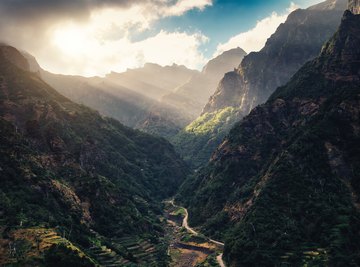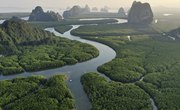
A basin is an area of land where surface water from rain, melting ice, snow and other sources descends and drains into a creek, lake, stream, river or its tributaries. Basins go by many other names including river basin, drainage basin, drainage area, catchment, catchment area, catchment basin or watershed.
How Basins Work
A basin is basically a geographic formation that acts as a funnel collecting water and channeling it to a single convergence point. Although each catchment area is separated from another by geographical barriers such as mountains and ridges, the areas are interconnected. Basins drain into one another depending upon the surrounding topography, until the water reaches its final outlet destination such as an estuary or the ocean.
Where Basins Are Located
Basins vary in size: some are small while others span across state or national borders. The Amazon, Congo and Mississippi River basins are the largest drainage basins in the world. According to the U.S. Army Corps of Engineers, the Mississippi Basin covers an area greater than 1,245,000 square miles, spanning across 31 states and two Canadian provinces.
Why Basins Are Important
Catchment basins are vital elements of the ecosystem in which soil, plants, animals and water are all interdependent. Basins are vital to human existence, since they provide clean water for drinking; water for growing food; and water to nourish plant life, which provides the oxygen people breathe. Historically, basins were also an important factor in determining geopolitical borders. In modern times, the responsible management of river basins is vital to commerce, transportation and agriculture as well as basic human survival.
Human Impact on Water Quality
As the North Carolina Office of Environmental Education and Public Affairs correctly points out, "everyone lives in a basin" and therefore the water quality downstream is affected by the actions of all people living on the land that drains into a river, creek, aquifer or other type of water body. Within a river basin, runoff from fertilizers and pesticides used in agriculture, industrial and household waste all eventually drain into a water source, disturbing the natural balance of minerals and, in turn, its quality.
